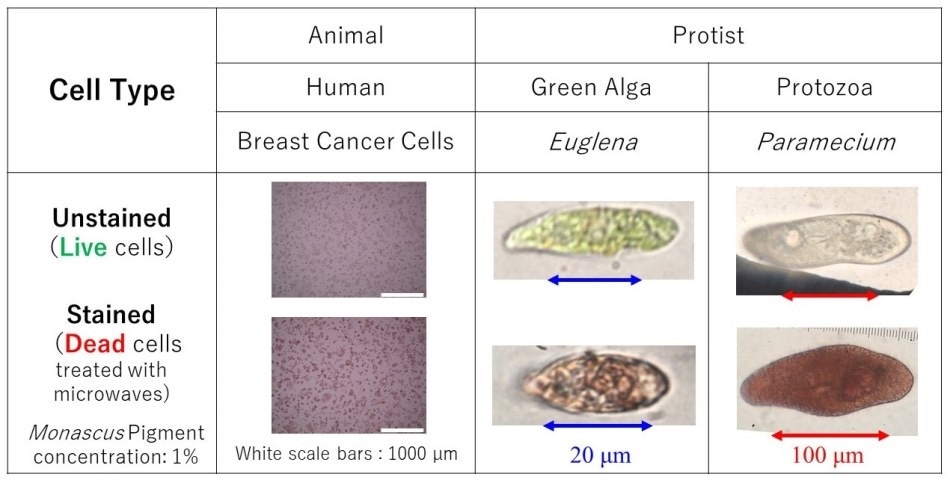Synthetic dyes are commonly used to assess the toxicity of chemical compounds in cell cultures. However, these dyes damage cells, rendering the cultures useless for long-term experiments. Recently, scientists from Japan discovered that a natural food pigment can replace synthetic dyes in cell viability assays for three widely varied types of cells—and performs better. Their approach is also environment-friendly and inexpensive, and opens up possibilities in a range of fields including drug discovery.

Staining live and dead cells using Monascus pigment solution. Live cells are not stained, but dead cells are stained.
Working with in vitro cultures is a relatively cost-effective and easily repeatable way of gaining insight into the interactions between cells or microorganisms and specific chemical compounds, such as drugs, nutrients, and toxins.
However, to properly assess the toxicity of a compound, a reliable and efficient way to distinguish live cells from cells killed due to toxicity is necessary.
Researchers have elucidated several methods to tell live and dead cells apart, and one popular approach is the "dye exclusion test (DET)" using synthetic dyes. In conventional DET, a dye such as trypan blue or methylene blue selectively permeates and stains dead cells, distinguishing them from live cells.
This seems simple enough, but these synthetic dyes have been known to damage living cells in the culture as well. This renders them unusable for long-term studies with a single culture.
Fortunately, as is described in their study published in MDPI Biology, a team of scientists from the Tokyo University of Science, Japan―comprising Assistant Professor Ryoma Tagawa, Professor Yoshikazu Higami, Professor Eiji Tokunaga, and Assistant Professor Kyohei Yamashita―recently discovered an alternative to DET with synthetic dyes: DET using a natural pigment made from Monascus purpureus (MP), a mold species traditionally used in Asia for the production of fermented foods.
According to Dr Yamashita, lead author of this and two other studies on MP, its discovery as a tool for distinguishing dead cells was a case of serendipity.
Dr Yamashita and a colleague were working alongside Dr Koji Yamada and Dr Kengo Suzuki from euglena Co., Ltd. to find effective ways of culturing Euglena gracilis, a type of single-cell algae, in foods, when they stumbled upon the usefulness of MP and another natural dye called anthocyanin pigment for studying cell health over time.
The results of their study are published in PeerJ in the world's first report on the application of natural food pigments in cell viability assays.
Dr Yamashita then went on to lead another study demonstrating the applicability of MP in DET for another single-cell organism species with a vastly different structure, Paramecium.
In their most recent study, the one published in MDPI Biology, Dr Yamashita and colleagues proved that MP can be used to ascertain the viability of breast cancer cells. They found that, unlike trypan blue, MP does not damage living cells and is robust against a typical chemotherapy drug cisplatin. Moreover, MP took only ten minutes to stain dead cells and costs a tenth of what trypan blue does.
The proposed natural pigment enables the long-term monitoring of the life and death of cells, which may bring about improvements in the efficiency of biomass production, basic research on metabolic mechanisms, and applied research in fields such as breeding.”
Dr. Kyohei Yamashita, Study Lead Author and Assistant Professor, Tokyo University of Science
In addition to its use as a reagent to monitor the life and death of cells, Dr Yamashita notes that the pigment is also nutritious to living cells and has antioxidative characteristics, which is useful for boosting culture efficiency and performing quality control in the food industry, where safe fermentation is critical. It is also safe to humans and the environment.
This applicability of MP to completely different kinds of cells--breast cancer, Euglena, and Paramecium--has made Dr Yamashita very optimistic about its potential.
Our natural pigment could be the tool that opens up new research fields involving the determination of the causes behind the death of cells. Moreover, natural pigments are highly likely to have useful properties that have not yet been found, and there is much room for exploration."
Dr. Kyohei Yamashita
There is certainly a bright and colorful future ahead for this promising natural dye!
Source:
Journal reference:
Yamashita, K., et al. (2020) Noninvasive and Safe Cell Viability Assay for Breast Cancer MCF-7 Cells Using Natural Food Pigment. Biology. doi.org/10.3390/biology9080227.